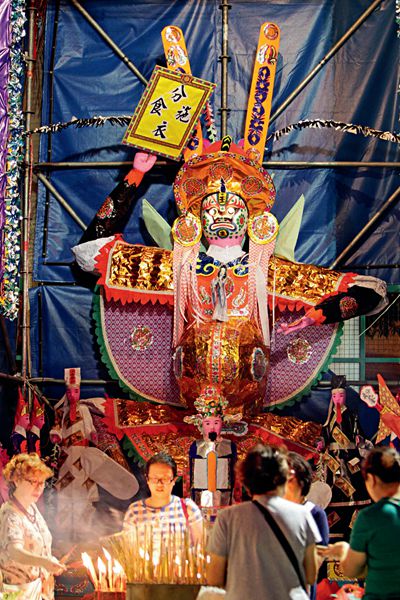Hong Kong's Ullambana Festival: Chinese halloween
 0 Comment(s)
0 Comment(s) Print
Print E-mail China Today, August 9, 2016
E-mail China Today, August 9, 2016
|
|
|
Local residents hold a three-day ancestor worship ceremony. |
Ancestor worship starts at noon of the festival. The Hungry Ghost Festival is as important an occasion in this respect as are the Tomb-sweeping Day in early spring and the Double Ninth Festival in autumn. On that day, each family prepares delectable dishes, and places seven pairs of chopsticks, seven wine cups, and one jug of wine on an old-fashioned square table, so to bless the family's health, safety, and prosperity. At night, family members bring firecrackers, joss paper, or paper money, and incense sticks. They find a secluded place near a riverside or pond and draw a circle with lime powder. Within it they burn joss paper, and set off firecrackers, and thus respectfully see their ancestors off to the nether world. With the advance of the times, people nowadays retain the sacrificial ritual only to cherish the memory of their forefathers.
Other regions observe conventions apart from those relating to ancestor worship, such as burning paper ingots. But floating river lanterns is the grandest and most picturesque.
Paper lanterns are floated on rivers and lakes to escort ghosts to paradise, or to be imminently reborn. These lotus-shaped lanterns are made of colored paper and contain oil lamps or lighted candles. When darkness falls, these glowing vessels bob on the waves like stars in the night sky. Whether or not a ghost has been saved is calculated according to how the lanterns float. One that swirls signifies that the ghost is entangled. One that sinks means that the ghost has been rescued and reincarnated as a new baby. If the lantern floats faraway or approaches the shore, it means the ghost has arrived at the other world and become an immortal.
People of southern Fujian and Taiwan make river lanterns in the shape of palaces. Inside the palace is a triangular paper flag on which is written their ancestor's name and honorific, to help ghosts find their family members. People in Jiangsu float four paper boats, one for hungry ghosts who spit fire, one to pray to Buddha, one to burn silver paper and ingots, and one on which to float lotus lanterns. People in Shanghai decorate these boats with red and green paper lanterns. Those most spectacular are launched by people in Shanxi. Regardless of age or sex, all gather along the Yellow River to float colorful lanterns. The children gaze at them to see how far they will go, while the adults pray.
The Ullambana Festival in Hong Kong
There are now 1.2 million residents of Hong Kong who are Chaoshan descendants and maintain the month-long Ullambana Festival tradition. It consists of ritual ceremonies, such as burning paper money and making sacrificial offerings of rice for safety, as well as of wine and meat, and drama performances. The festival takes place at more than 60 sites on Hong Kong Island, Kowloon, and the New Territories. At that time the sight of locals burning incense sticks and paper money on roads and in lanes to worship deceased relatives and release their souls from suffering is commonplace. At early morning, local communities are speckled with sacrificial offerings of rice and fruits. This simple ceremony links the temporal and nether worlds, and so pacifies hearts on both sides. Altars and religious rites are hence grand. People burn incense sticks to pray for their family members' well-being, and the curling smoke from incense sticks carries their wishes and leaves them benedictions. These traditions have become a part of local people's daily life.
These structures are generally in the form of bamboo sheds. Lanterns with streamers lead the way, to help ghosts find and enjoy tributes. The first bamboo shed houses the main altar, where Buddhist monks and nuns chant sutras for three days and nights to release souls from torment. The second one is to worship heaven, earth, and parents. It contains various decorative lights and offerings, and visitors are received on either flank. The third one enshrines the Boddishatva Avalokitesvara, whose infinite compassion is intended to inspire the hosts. There is also a blue-and-white stage on which to greet and escort ghosts away from the underworld. The largest shed is used to perform different dramas, in particular Chaozhou opera, for the free delectation of local residents.







Go to Forum >>0 Comment(s)